The importance of subject headings in a library catalogue can often go unnoticed. Consistent subject headings comprising what are known as ‘controlled vocabularies’ can be the difference between finding the resources you’re looking for quickly or wasting time attempting multiple searches that yield frustratingly few useful results.
Many people do not know, and would not suspect, the intricate way that subjects must be linked through their synonyms and related concepts to allow users to effectively explore a catalogue, linking terms and concepts with each other, such as ‘dogs’ and ‘animals’.
This article delves into the evergreen world of SCIS subject headings; a unique and comprehensive index of relevant subject headings that work silently in the background to help create a quality search experience in schools.
What is a Subject Heading
Every record in SCIS Data contains subject headings that indicate the topical content of the resource. SCIS makes use of two different controlled vocabularies:
- SCIS Subject Headings List (SCISSHL) https://my.scisdata.com/standards
- Schools Online Thesaurus (ScOT) http://scot.esa.edu.au/
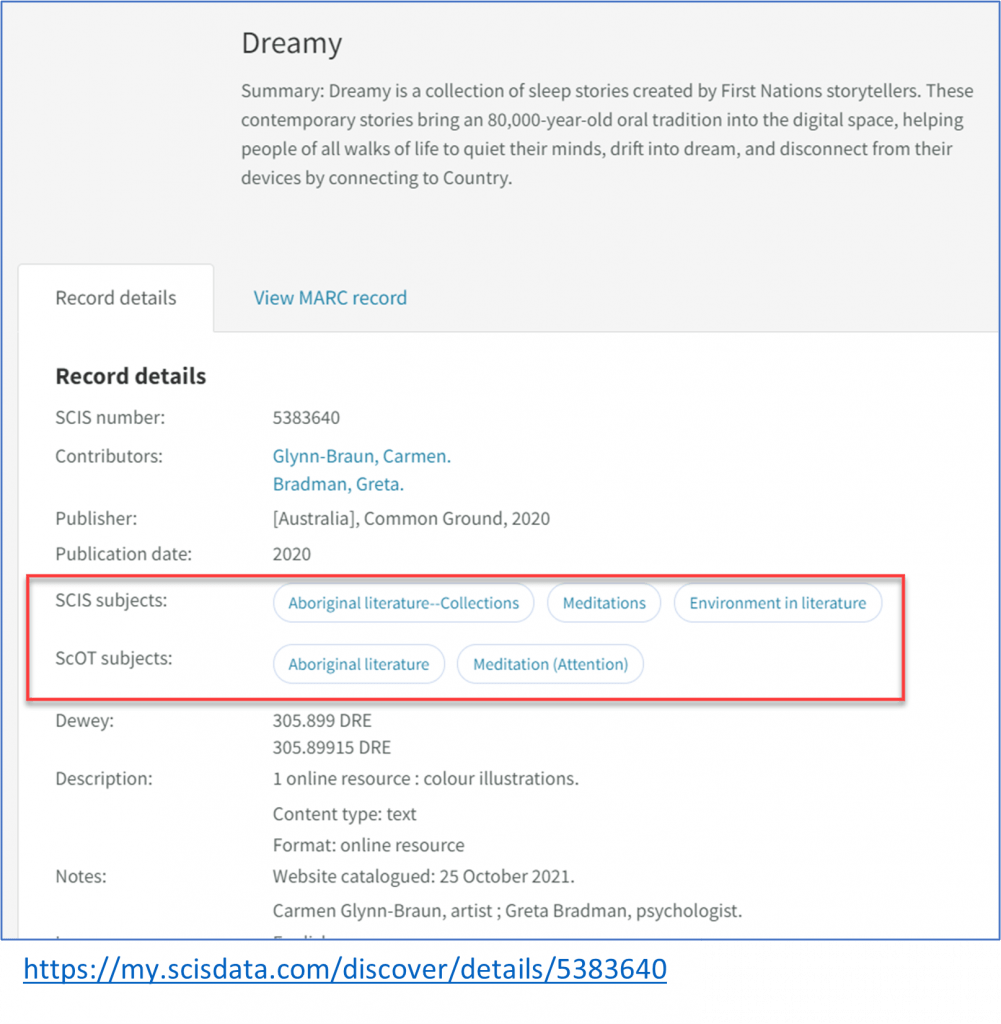
Subject headings in a bibliographic record have three key purposes:
- To assist end-users to find the resources required to meet an information need;
- To enable end-users to assess whether a resource contains the information required to meet an information need; and
- To facilitate exploration of the database, locating similar resources.
Library catalogue advanced search interfaces rely on controlled vocabularies (explained below) to be effective. A search within the subject field uses controlled vocabularies; faceted searches (sometimes called search limiters) use controlled vocabularies


Controlled Vocabluries
Controlled vocabularies are “established list of preferred terms from which a cataloger or indexer must select when assigning subject headings or descriptors in a bibliographic record, to indicate the content of the work in a library catalog, index, or bibliographic database”.[1]
Controlled vocabularies are an essential tool cataloguers use to ensure consistency of terminology. These lists ensure that an entity in a bibliographic database, whether it be a concept, object, person, place or event, is represented by a consistently used term or phrase.
For example, the concept ‘Disasters’ has synonyms ‘Calamities’ and ‘Catastrophes’. A controlled vocabulary will identify which term is the ‘authorised’ one, the one that will be used to identify resources about this concept. End-users using the terms ‘Calamities’ and ‘Catastrophes’ are referred to resources with the controlled term ‘’. This is important for an end-user because it means that a search for ‘calamities’ or ‘catastrophes’ will refer to the concept ‘disasters’ in order that both searches will not miss potentially relevant resources.
Uncontrolled Vocabularies
On the other end of the vocabularies scale are uncontrolled vocabularies, sometimes called folksonomies. These are lists of terms or words or phrases selected randomly, with no set list to choose from. Tag or hashtag lists, such as those used in social media sites such as Instagram, are folksonomies; they are not controlled. The terms are random and unrestricted, resulting in duplication, misspelling and incongruity. Some terms in a folksonomy may have no meaning to anyone, other than the creator of the tag. Uncontrolled vocabularies means that the user needs to guess what tags or headings have been allocated to a resource to find it.
References
Controlled vocabularies ensure consistency. End-users of databases with controlled vocabularies can be confident of locating all resources on a particular topic, especially because controlled vocabularies use cross- references.
References ‘refer’ end-users from unused terms to used headings, and between related used headings.
For example:
A search for ‘Natural disasters’ in SCIS Data will refer users to the used heading ‘Disasters’.
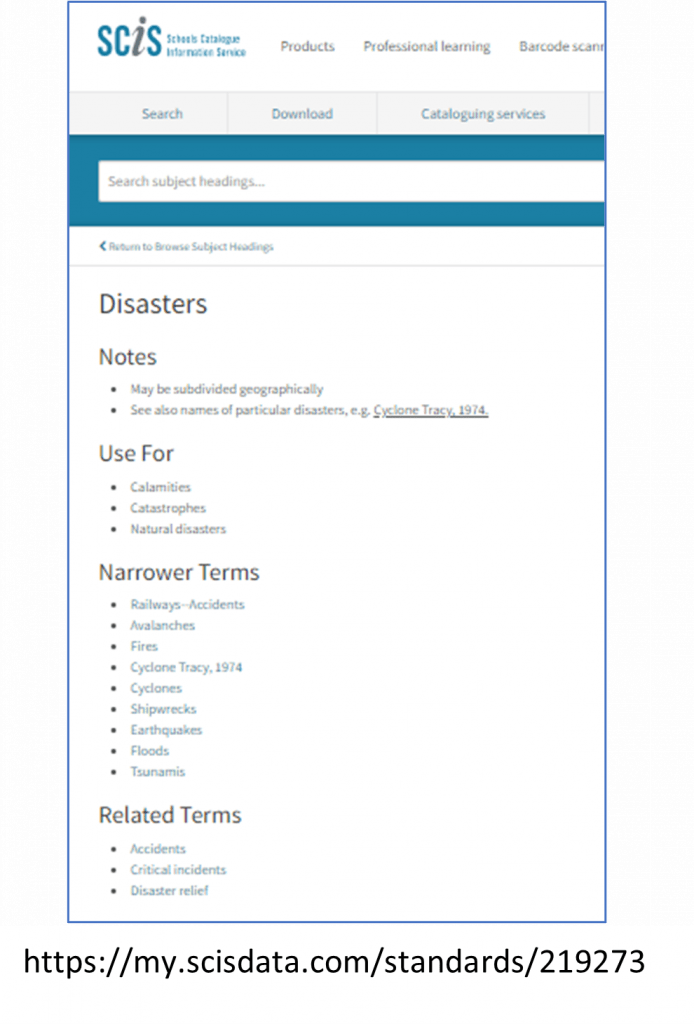
A search for Disasters can refer end-users to narrower headings such as ‘Avalanches’ and ‘Earthquakes’, or related terms such as ‘Accidents’ or ‘Disaster relief’.
SCIS Subject Headings List – a controlled vocabulary
SCIS Subject Headings List is the controlled vocabulary created to support the SCIS bibliographic database. It was first published in 1985, titled ASCIS Subject Headings, as a print volume. The fifth, and final print edition, was published in 2002. SCISSHL is now available as an online resource on the SCIS Data website https://my.scisdata.com/standards.
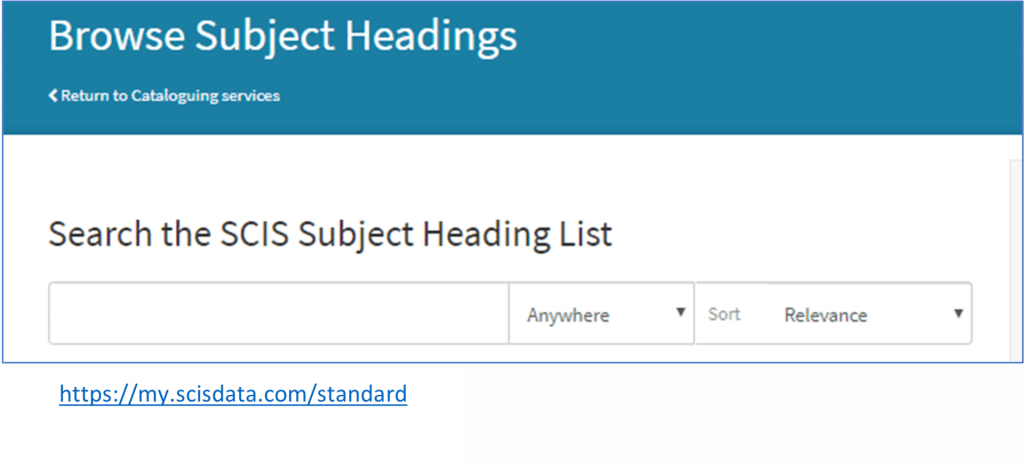
SCIS Subject Headings List is the ‘source of truth’ or ‘core’ used by SCIS cataloguers when selecting or devising appropriate subject headings for educational and curriculum resources catalogued into the SCIS Data. The list can be used by schools that subscribe to SCIS to assist their library staff in conforming to SCIS standards when adding subject headings to local resources.
SCISSHL contains
- an alphabetical listing of used and unused headings, with scope notes (definitions) if required);
- cross-references from unused to used headings and between allowed headings; and
- a set of prescriptive guidelines for the construction of other headings not in the list.
Using https://my.scisdata.com/standard
Entering a term into SCISSHL browse immediately presents the user with a list of terms.
- Blue words are used headings. The hyperlink opens the record for that heading.
- Grey italics terms are unused. The hyperlink opens the record for the related used heading.
For example:
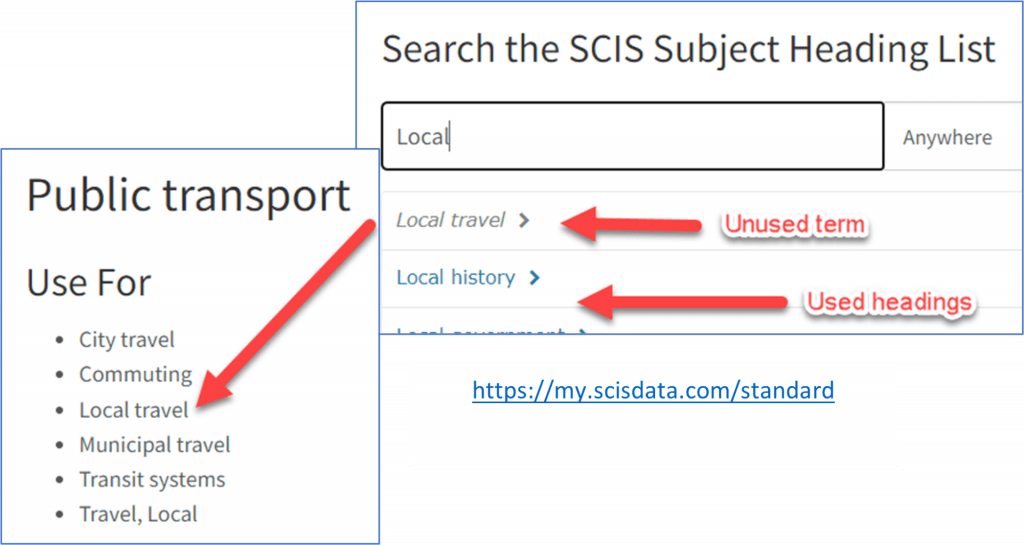
Clicking on unused term, ‘Local travel’, opens the related used heading, ‘Public transport’.
Clicking on the used heading, ‘Local councils’, opens the full heading for that allowed term.
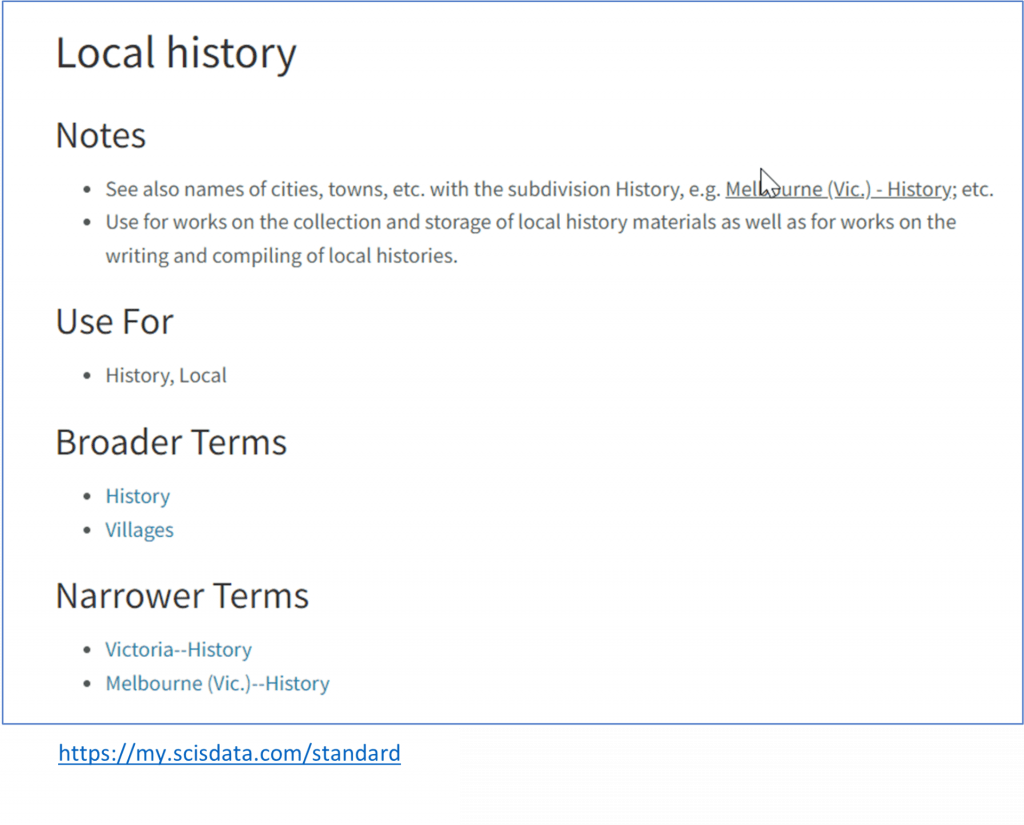
Heading records in SCISSHL
A heading record may have one or more of the following:
- Use for Unused terms which are referenced to this used heading.
- Broader terms Used headings which are broader in concept than the lead heading.
- Narrower terms Used headings which are narrower or more specific that, the lead heading.
- Related terms Used headings which are associated with the lead heading in some way other than hierarchically.
- Notes May provide:
- a definition on the usage and scope of the heading;
- instructions on how the heading can be used; and/or
- instruction on devising more specific headings.
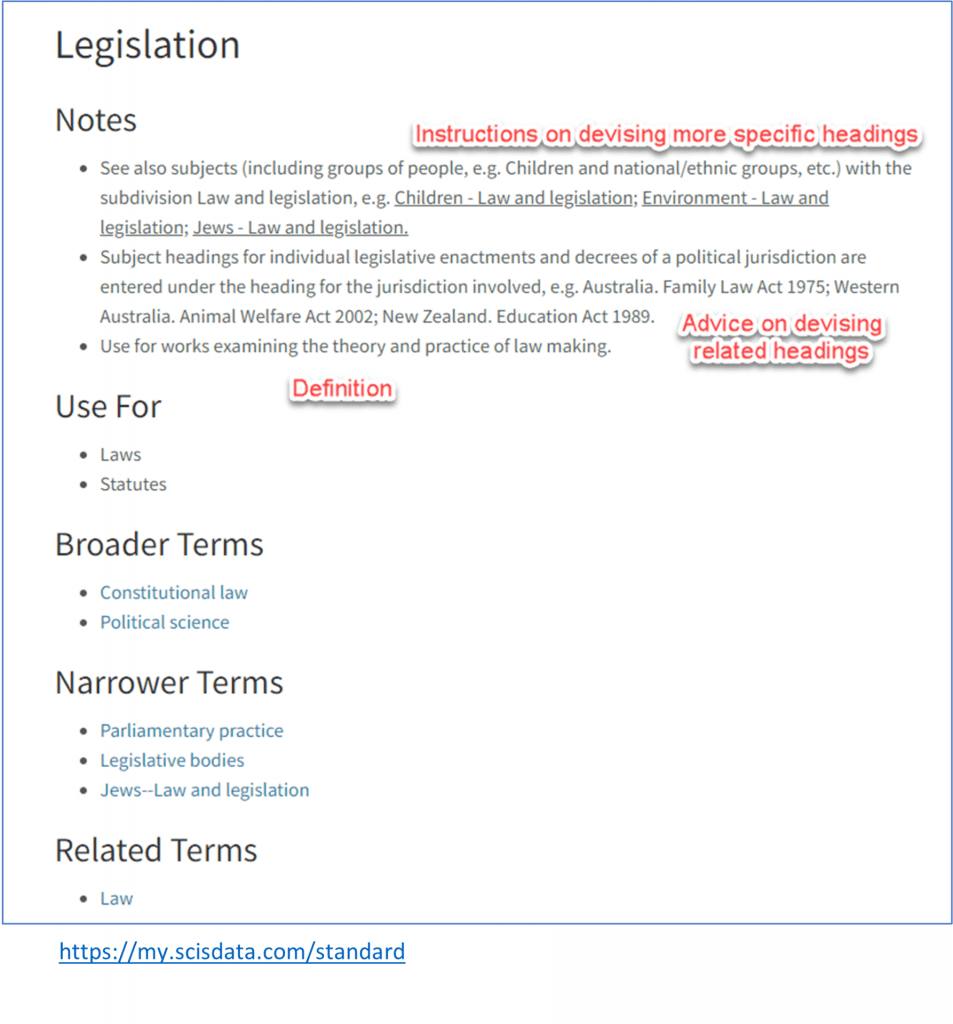
Subject Authorities of SCISSHL
In SCIS Data there are two sources of subject headings that cataloguers can use
- https://my.scisdata.com/standard – SCIS Subject Headings List (SCISSHL)
- https://my.scisdata.com/discover/thesaurus – SCIS search – Browse headings – Subject (Subject authority list)
SCISSHL is the tool that cataloguers use to add subject headings to a resource record. It provides instructions on devising further headings, as it would be impossible to make a list of all headings, including proper and common nouns headings that are needed for a general catalogue, for example the name of every order, class or species of animal.
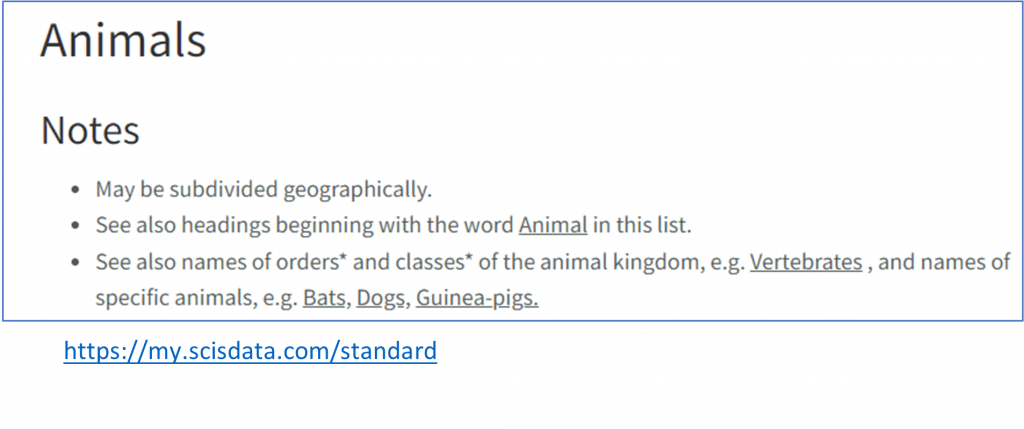
SCISSHL does not point end-users to actual resources. It is the core list of headings, also called the ‘standard’, that is used by cataloguers.When an end-user uses a subject advanced search, or a subject browse search in a public catalogue, the search funcaiotnliaty, uses what is known as the subject authority list to retrieve resources.
The SCIS subject authority list includes the ‘core’ SCISSHL headings as well as all the devised, or created headings, used in the SCISData database catalogue. The subject authority list in a schools’ library management system includes all the subject headings allocated to resources in the school library. Ideally it also contains all the references (Used for, Broader, Narrower and Related terms), to allow the end user to navigate from one heading to other related headings, enhancing the effectiveness of a catalogue search.
The browse subject heading option in SCIS Data search searches all headings used in the SCIS Data subject authority list, the core headings from SCISSHL as well as devised headings.
For example:
A search for ‘Ice age’ in SCISSHL will only retrieve the core heading, as it is only searching the core headings
A search for ‘Ice age’ in Browse headings will retrieve the allowed devised headings as well, making it effective for the end-users, not just cataloguers.
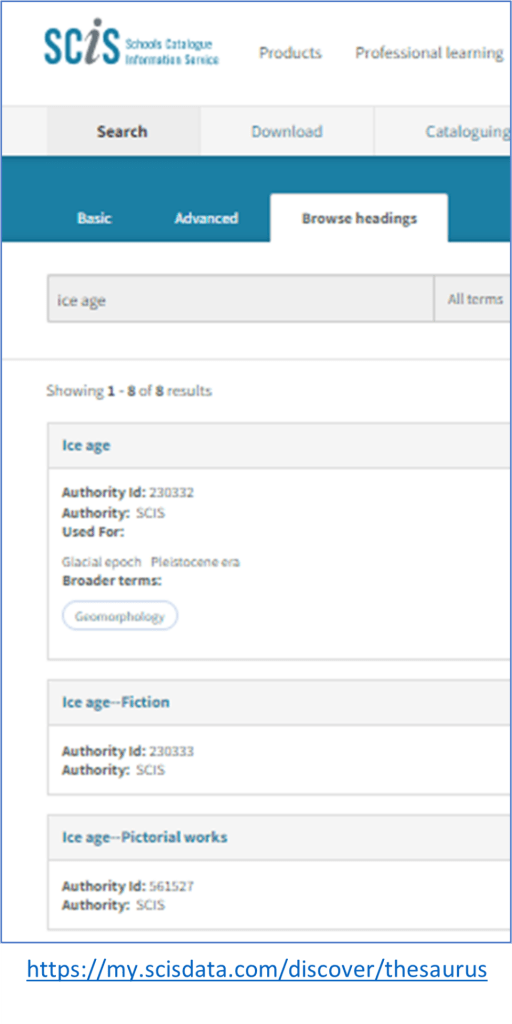
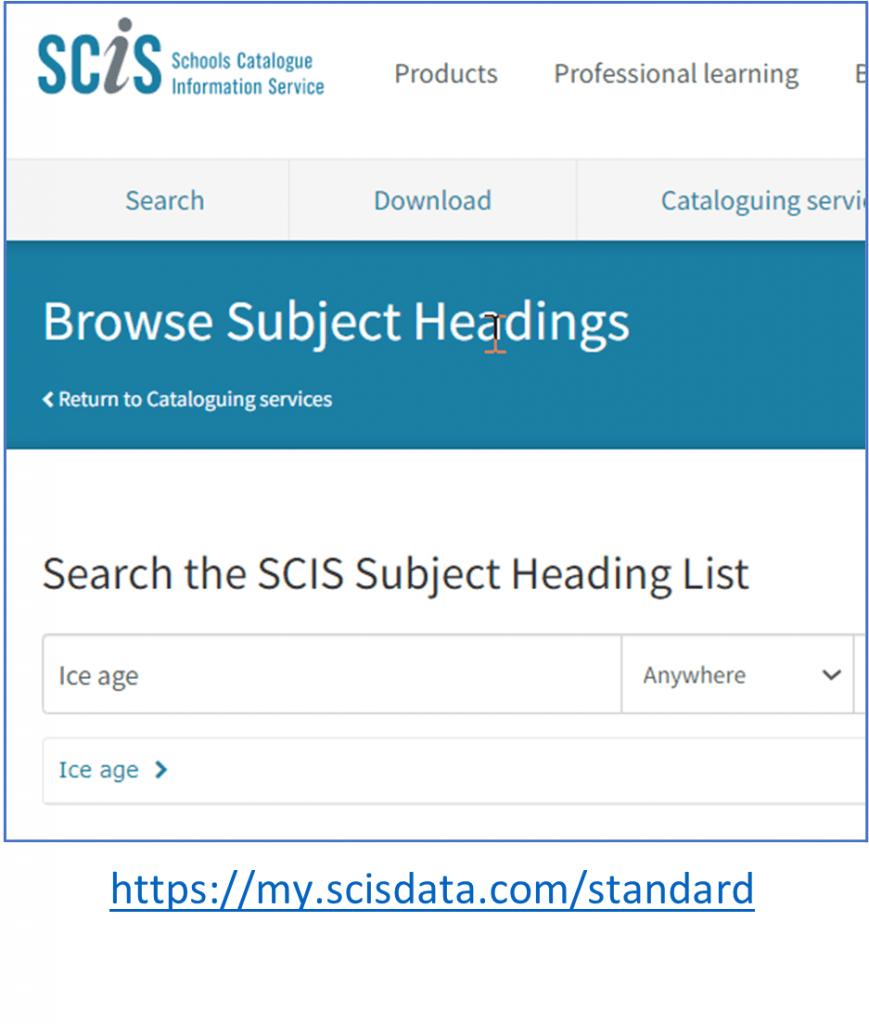
SCIS Authority Files
Maintaining accurate authority lists and references is time consuming as it includes devising new headings and adding cross-references between new headings and existing headings. To help with this, SCIS provides the option to subscribe to the SCIS authority files, which lists all core and devised headings used in the SCIS Data.
There are two options for downloading SCIS authority files found at https://my.scisdata.com/authorities:
- Reference only files. Only includes headings which have references (Used for, Broader, Narrower and Related terms).
- Full files. Includes all headings in SCIS data authority files, whether they have references or not.
How the headings and references are displayed to end-users depends on the library management system. In most cases only the heading and related references used in a school library database will be displayed for end-users. Cataloguing staff would see all the headings imported from SCIS Data. It is strongly suggested that library system vendors be consulted before importing the full authority files.
Updating and revising SCIS Subject Headings
SCISSHL is continually updated and revised. New headings are added, references structures reviewed, heading using out-dated terminology are updated. These are presented in the term 1 issues of Connections.
The SCIS Standards Committee is responsible for maintenance of the SCIS Standards for Cataloguing and Data Entry and for SCIS Subject Headings List. The Committee meets four times a year, considering working papers for new and revised headings after undertaking a thorough consultation process.
SCIS subscribers can recommend additions and changes to SCISSHL by emailing help@scisdata.com. Reasoning for the suggestion should be added. These suggestions will be reviewed by the SCIS Standards Committee.
